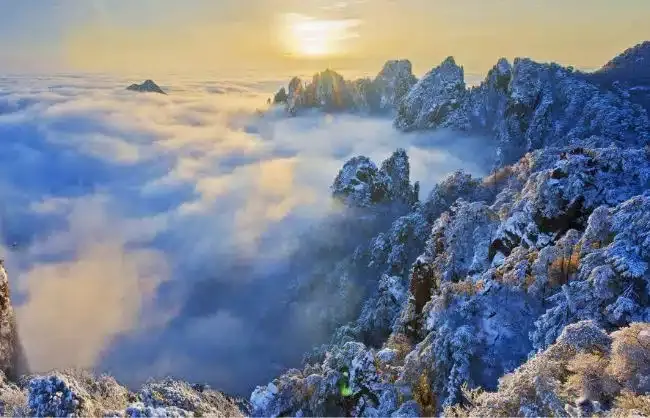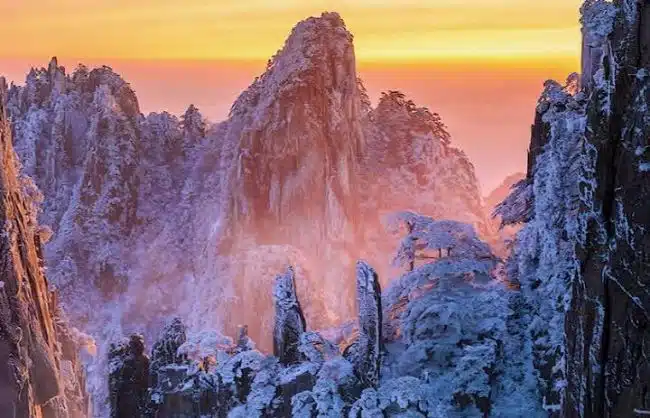Huangshan Mountain sees its off season in winter, but it offers no less stunning sceneries than other seasons. Each year, from December to February, Huangshan will transform into a snowy wonderland, blooming with its enchanting winter charm.
Unlike the lush and vibrant scenes of other seasons, winter in Huangshan allows you to see its “Four Wonders” – peculiar pine trees, unique rock formations, seas of clouds, and hot springs appearing more mysterious against the icy backdrop.
To travel to Huangshan Mountain in winter, you can encounter the peculiar pine trees and rocks draped in shimmering rime. Stand atop a peak and witness the frost appearing together with dreamlike sunrises, sunsets, and the rolling seas of clouds. After a scenic hike, you can enjoy an unparalleled experience of soaking in the misty hot springs, surrounded by the crisp winter air. With fewer crowds, a Huangshan winter tour not only offers a unique tranquility but also more affordable prices.
In this article, we’ll share plenty of Yellow Mountains’ winter charms and travel tips, including winter weather, temperatures, wonders in winter, packing list and more.

Huangshan Weather in Winter– December, January, February
Huangshan’s winter typically lasts from December to February the next year. The winter weather in Huangshan is characterized by dry and cold conditions, and significant temperature difference between day and night. Its average winter temperatures usually range between 0°C and -6°C, with extreme lows can reach -15°C, or even lower. Summit temperatures can be 8-10°C lower than those at the base.
Precipitation in winter is relatively low compared to other seasons, and often takes the form of snow instead of rain. On average, the snow can cover the mountain for about 50 days in winter, with the heaviest snowfall typically occurring in January and February.
Thanks to the minimal atmospheric disturbances, and stable cloud layers during this period, winter offers the best conditions for viewing Huangshan’s magnificent sea of clouds.
Overview of Temperatures & Rainfall in Huangshan in Winter
| Month | December | January | February |
| Average Temperature at Mountain Base (°C) | 4-8 | 0-6 | 5-10 |
| Average Temperature at Mountain Summit (°C) | -2-3 | -6-0 | -3-4 |
| Average Monthly Precipitation (mm) | 70 | 60 | 90 |
| Rainy/Snowy Days Frequency | 8-10 | 10 | 12 |
Note:
- With wind chill, the perceived temperature can be even lower on the mountain summit.
- Over 80% of winter precipitation on the summit is snow or sleet.

What to Wear & Pack in Huangshan in Winter
Huangshan in winter experiences relatively low temperatures, and slippery trails. The following clothing and packing guide will help you safely experience its rime ice, seas of clouds, and breathtaking sunrises and sunsets, while balancing warmth and flexibility.
Clothing Guide: Three-Layer Dressing + Windproof and Waterproof
- Base layer: Quick-dry thermal underwear, and fleece Vest (optional for high altitude). Avoid cotton underwear as it may easy to become damp after sweating, and lead to loss of body heat.
- Mid layer: Fleece jacket, or light down liner (with more than 100g down filling), and fleece-lined softshell pants.
- Outer layer: Hard-shell jacket, or thick down jacket, hard shell pants with gaiters to prevent wind and snow ingress. Prepare a raincoat in case of freezing rain or heavy snow.
- Footwear: High-top waterproof hiking boots, and wool socks.
- Accessories: Fleece hat (cover ears), snow goggles, windproof face mask, waterproof gloves, wool scarf, etc.
Other Essential Items
- Hiking gear: Basic ice crampons (can buy some at the base of the mountain), a trekking pole, headlamp (for early morning hikes to catch the sunrise).
- Heat packs: Apply to abdomen, back, and soles (average of 4-6 packs per day).
- Moisturizing kit: lip balm, hand cream, etc.
- Common medications: Frostbite cream, band-aids, painkillers, ibuprofen, etc.
- Energy supplies: High-calorie snacks, such as chocolate, compressed biscuits, and beef jerky. A thermal flask.
- Power bank: As batteries lose capacity in cold temperatures.
- Backpack: Carry snacks, water, and other personal items.
What to See on a Winter Tour to Huangshan Mountain – Sea of Clouds, Sunrises, Rime, Winter Snow
Attractions Open in Winter in Huangshan
Most major attractions of Huangshan Mountain are open in winter. But, due to the icy conditions, certain rugged and high-risk attractions will be closed during the winter months (typically from December to March). Despite the closures, the winter open areas can still offer you spectacular views of snow, rime ice, sea of clouds, and more. Below are the specific closures and open areas for your reference:
Winter Open Attractions:
- Beginning-to-believe Peak: Features unique pine trees and peculiar rock formations. The peak offers stunning snow scenes and rime ice in winter.
- Bright Summit: As the second-highest peak in the Yellow Mountains, Bright Summit offers great views of the sunrises, seas of clouds, and the surrounding snow-capped landscapes.
- North Sea Scenic Area: The classic Lion Peak, and Monkey Watching the Sea are all located in this area. After a snowfall, it will transform into a fairy-tale world.
- Guest-greeting Pine: An iconic pine of Huangshan, the tree is more majestic when covered by snow and ice.
- Aoyu Peak, Flying Stone, Paiyun Pavilion: All are great viewing platforms for the snow-covered rocks and deep canyon vistas.
- Danxia Peak and Qingliang Terrace: An ideal spot to enjoy morning mists, sea of the clouds, and snow-covered pine forests.
Winter-closed Attractions
- West Sea Grand Canyon: Typically close from December 1st to March 31st. Because the snow-covered trails are dangerous.
- One-line Sky: Also close from December 1st to March 31st. The narrow, steep and icy trails make the hiking risky.
- Tiandu Peak & Lotus Peak: These two peaks follow a five-year rest cycle for ecological protection. (Tiandu Peak reopened in 2024, while Lotus Peak is currently in its resting phase). They remains closed from December 1st to March 31st even during their open cycle.

The Sea of Clouds
The sea of clouds is one of the most famous natural wonders of the Huangshan Scenic Area. It refers to a spectacular natural phenomenon where the low-altitude clouds gather, creating an ocean-like landscape that envelops valleys and peaks. In winter, the probability to witness this wonder is much higher than any other seasons. And the sea of clouds usually can remain suspended for up to 6-8 hours in this season, much higher than in spring and autumn.
Recommended viewing spots: Bright Summit, Paiyun Pavilion, Begining-to-believe Peak, West Sea Hotel, Lion Peak, etc.
Winter Snow in Huangshan
December to February is the prime snow season in Huangshan, makeing it the best time to enjoy its unique winter landscpaes. When the winter snow blankets the mountain range, the iconic pines, peaks, rock formations, and sea of clouds all present a completely different look from other seasons.
By then, rime ice and icicles will transform pine needles and rocks into glittering works of art. The snow-covered “Monkey Watching the Sea” and the “Flying-over Rock” stand out like giant sculptures. The scenery is even more enchanting when golden sunrises cast a magical glow on the snow-covered peaks.
Hot Springs
In winter, hot springs hidden in Huangshan Mountain Scenic Area will offer a magical “ice and fire” experience. Imagine soaking in a 42°C hot spring after a scenic hiking, while being surrounded by the snow-covered wonderland, rime ice and cloud seas. As one of the Huangshan Four Wonders, Huangshan’s hot springs are the only one located within granite fissures. With a stable water temperature of 42°C, it is said to have therapeutic benefits for your overall health.
Recommended Huangshan Hot Springs:
- Huangshan Piaoxue Hot Spring: Located in the Hot Springs area of the Huangshan Scenic Area, on the southern bank of Xiaobu Bridge, adjacent to the main peak of Huangshan.
- Xiangyuan Yungu Holiday Hotel: With open-air hot spring availabl Located next to the Yungu Temple Cable Car.
Best Huangshan Tours
- Huangshan Day Tour With Round Way Cable Car
- 3 Days Mount Huangshan Hiking Tour
- 4 Days Huangshan Tour with Hongcun & Xidi Villages
- 4 Days Huangshan Winter Tour with Hot Spring
Useful Travel Tips for a Huangshan Winter Tour
- Please take regular breaks during the hiking. For example, rest for 5-10 minutes after every 30-40 minutes of hiking.
- Since hiking consumes a lot of energy, please carry some high-calorie snacks like chocolate, beef jerky, or energy bars.
- After your Huangshan Mountain hiking, you can visit some nearby ancient villages, such as Hongcun Villageand Xidi Village. These villages are all rich in Huizhou culture and is very peaceful in winter.
- Sunscreen and sunglasses are still essential in winter as the UV rays on the mountain can be strong.
- Remember to book your entrance tickets one day in advance. If plan to stay overnight on the mountain, you’d better reserve the hotel about 3 days early.
- You can dicide hiking or taking a cable car up the mountain based on the physical condition. Most visitors choose to take a cable car to up. Even though, some walking and hiking are still needed.
- When walking on icy surfaces, try to take small steps and walk slowly. You can lean slightly forward and use the “penguin walk” to avoid slipping or losing balance.
- For those with high blood pressure or heart conditions, please choose lower-temperature hot spring pools (≤39°C), and don’t soak over 15 minutes one time.
- After soaking, wrap yourself up quickly in a thick towel to avoid temperature shock.
- Usually, private hot spring rooms should be reserved one day in advance.
- Note that the operating hours of Yungu and Yuping Cable Cars are shortened (8:00 AM – 4:40 PM ), so plan your descent time accordingly.









